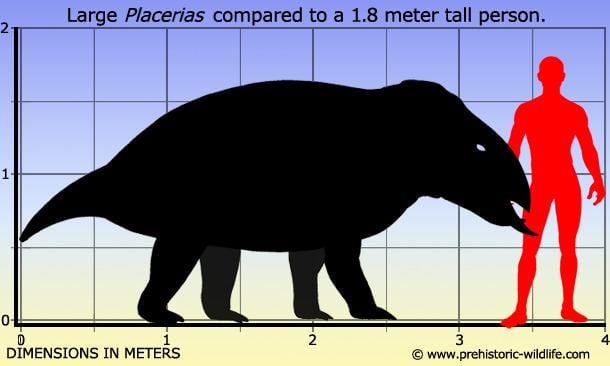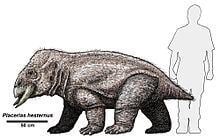Scientific name Placerias Higher classification Kannemeyeriidae Order Therapsid | Species †P. hesternus Phylum Chordata Rank Genus | |
 | ||
Similar Postosuchus, Dicynodont, Synapsid, Therapsid, Coelophysis | ||
Placerias
Placerias (meaning broad body) is an extinct genus of dicynodonts that lived during the late Carnian age of the Triassic Period (221-210 million years ago). Placerias belongs to a group of dicynodonts called Kannemeyeriiformes, which was the last known group of dicynodonts before most of dicynodonts became extinct at the end of the Triassic.
Contents

Placerias vs coelophysis
Description

Placerias was one of the largest herbivores in the Late Triassic, measuring up to 3.5 metres (11.5 ft) long and weighing up to a tonne (1000 kilograms). with a powerful neck, strong legs, and a barrel-shaped body. There are possible ecological and evolutionary parallels with the modern hippopotamus, spending much of its time during the wet season wallowing in the water, chewing at bankside vegetation. Remaining in the water would also have given Placerias some protection against land-based predators such as Postosuchus. Placerias used its beak to slice through thick branches and roots with two short tusks that could be used for defence and for intra-specific display. Placerias was closely related to Ischigualastia and similar in appearance.
Discovery

Fossils of forty Placerias were found near St. Johns, southeast of the Petrified Forest in Arizona. This site has become known as the 'Placerias Quarry' and was discovered in 1930, by Charles Camp and Samuel Welles, of the University of California, Berkeley. Sedimentological features of the site indicate a low-energy depositional environment, possibly flood-plain or overbank. Bones are associated mostly with mudstones and a layer that contains numerous carbonate nodules. It is also known from the Pekin Formation of North Carolina.
It was originally considered the last of the Dicynodonts, but recent fossil finds from Queensland revealed that the Dicynodonts actually survived until the Early Cretaceous.
